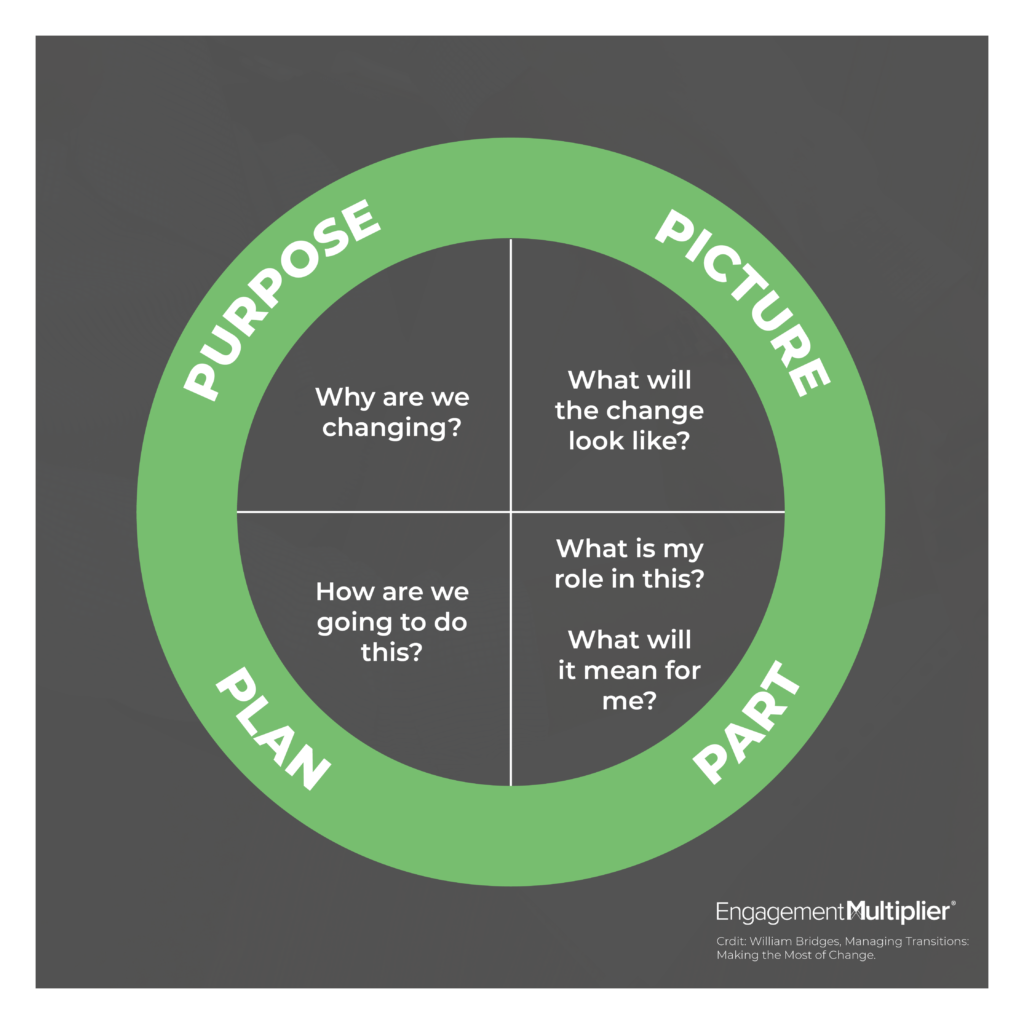Leading change successfully starts with getting people to ‘buy in’ to the change, a step many of the popular approaches to change management skip. When leading change, it’s not uncommon for leaders to assume employees will simply go along with leadership’s edict. In reality, leading change management is incredibly complex, and if employees don’t understand or believe in the coming changes (or worse, are threatened by them,) the plans can quickly derail.
Whether you’re planning on bringing people back to the office after a long stint of working from home, are implementing automation of processes, or are embarking on a new business model, the key to success is getting employee buy-in: in fact, it can make or break just about any change strategy.
Why employee buy-in is crucial when leading change
Employee buy-in is multifaceted. First and foremost, it means employees understand and are committed to the company’s goals and objectives, and have a clear understanding of leadership’s vision and strategy. Additionally, an element of buy-in is achieved when employees also understand how their roles are involved in and contribute to the change at hand, which is especially important for those who will be directly impacted by the coming change. Lastly, buy-in involves belief: belief the change will benefit the company, its customers, and employees individually. Assessing the change through the “what’s in it for me” lens through which employees view leaders need to ensure they address employees’ concerns and uncertainties thoroughly.
As you think about these three elements – understanding of the goals, clarity of one’s role, and true belief in the reasons for the change – it’s easy to understand why employee buy-in plays such an important to successfully leading change.
- Understanding the goals, as well as leadership’s vision and strategy, provides important contextual guard rails that guide decision-making and ensure people are aligned and focused on the right things.
- Having clarity around one’s role and responsibilities ladders neatly up to the prior point, helping employees stay connected to the larger strategy and work in clear alignment with stated objectives. However, there’s more to this than simply keeping people aligned. A clear understanding of one’s role and responsibilities also helps inculcate a sense of belonging: people can see how they fit into the bigger picture, and how their work contributes to the overall success of the organisation.
- Belief is the real kicker and can play an outsize role in determining the success of the change strategy. When people truly believe a change will benefit their customers, the company, and themselves, an extra source of energy and enthusiasm is formed. Conversely, when employees believe the change threatens them or is poorly considered, the project’s success becomes significantly less likely.
Not coincidentally, the three elements of buy-in noted above are also foundational components of employee engagement. Thinking about keeping your employees engaged throughout a significant period of change is useful: in both applications, employee engagement is fluid, responding to peoples’ changing circumstances. Adopting that mindset and approaching employee buy-in as an ongoing process, not a static endpoint, will help change leaders communicate more effectively.
The Four P’s of Change Management
Noted author and leadership guru William Bridges offers a framework in his book, ‘Managing Transitions: Making the Most of Change,’ for leading change that acknowledges the importance of bringing employees with you on the journey. Nicknamed ‘The 4 P’s’ the four elements address the elements required to achieve buy-in. They are:
- Purpose – Describe why the change is being made,
- Picture – Paint the picture of the future,
- Plan – Describe the steps the organisation will take to get there,
- Part – Explain what people need to do to make successful change a reality.

This simple framework is useful for outlining the conversations that need to occur across the organisation, down to the individual level, and throughout the change process. By starting with these four elements, leaders can both ensure consistency whilst also providing departmental leaders with enough flexibility to ensure the Plan and Part components are personalised for different roles.
Measuring employee buy-in
Leading change entails leading a process and keeping it on track. Measuring employee buy-in throughout the process enables leaders to stay on top of employee sentiment and identify opportunities to either correct perceptions or fix real issues before they blossom into full-fledged problems.
There are a variety of ways to measure buy-in, keeping in mind that buy-in occurs when people have an understanding of the goals and strategy, clarity around their own role and responsibilities, and have true belief in the reasons behind and the objectives of the change that’s at hand. These include:
- Employee surveys. Whether you elect to create and field an on-demand survey focused on gathering feedback about the change process, or you decide to simply add related custom questions to a regularly scheduled survey, using surveys to gauge buy-in is most effective when you used at intervals to gauge changes in how people are feeling and to catch any issues that may be cropping up.
- Manager feedback. Your own managers are a vitally important source of information – especially those whose teams are closest to the change. Creating an opportunity for them to confidently provide their candid feedback can be an important source of truth, and also enable leaders to reach in and provide extra attention where it’s needed.
- Timelines and project scope. Keeping track of related project milestones and status can be an important indicator of employees’ understanding of objectives and their respective roles. When timelines are missed and project scope balloons, that’s a red flag for leaders, indicating some clarity around objectives has been missed.
As you can see, generating true buy-in requires more than one message. However, the importance of getting employee buy-in is essential to successfully lead through change: it creates the alignment and energy necessary to achieve change and make it stick.



